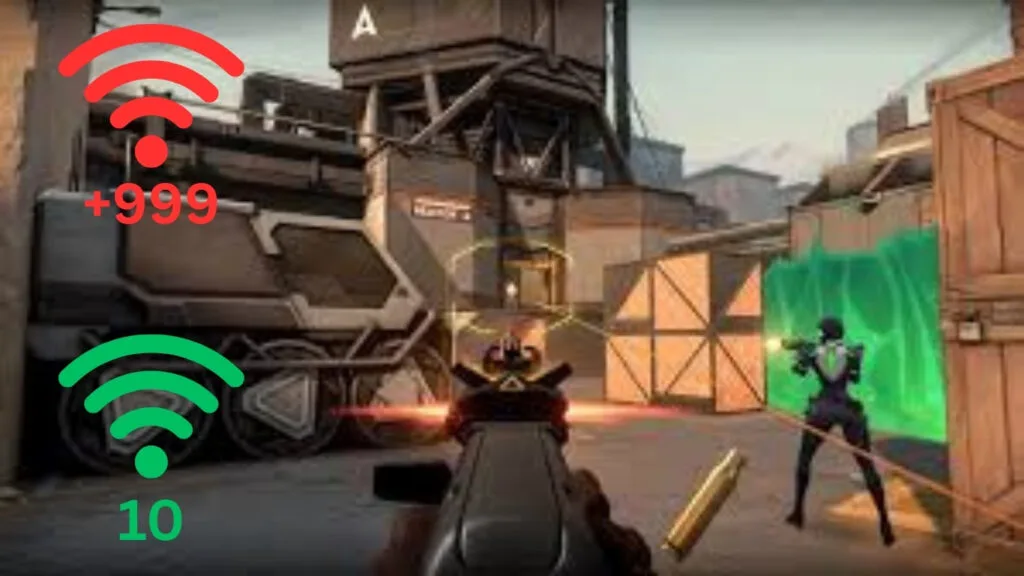Causes, Fixes, and Pro Tips for Lag-Free Gameplay
If you’ve ever played Valorant and thought your bullets weren’t hitting, enemies were teleporting, or your game was a second behind, you probably had high ping in Valorant. High ping can ruin your rank and your whole gaming experience in a competitive shooter where every millisecond counts.
This guide will tell you what ping means in Valorant, why you get high ping, how it affects gameplay, and the best ways to quickly lower your ping.

What Does Ping Mean in Valorant?
Ping is the amount of time (in milliseconds) it takes for your computer to talk to Valorant’s servers.
- 0–40 ms (Low Ping): Responsive and smooth.
- 40–90 ms (Medium Ping): You can play, but there will be some lag.
- 100+ ms (High Ping): Problems that are very noticeable and ruin the game.
In Valorant, even a small ping delay can be the difference between winning and losing a duel.
How High Ping Affects Valorant Gameplay
High ping not only makes your connection slower, but it also changes how Valorant feels. Some common problems are:
- Input Lag: Shots and abilities that take longer to happen.
- Rubber-Banding: Your agent snaps back after they move.
- Problems with hit registration: Bullets miss even when the crosshair is perfectly placed.
- Teleportation of enemies: Enemies show up in random places.
- Frustration and rank drops: High ping makes competitive play impossible.
READ MORE : VALORANT Champions 2025: Complete Roadmap Explained
Common Causes of High Ping in Valorant
Wondering why is my ping so high in Valorant? Here are the most common reasons:
| Cause | Explanation |
| Weak Wi-Fi or Internet Plan | Unstable speeds cause delays |
| Server Distance | Playing on far-away Riot servers increases ping |
| Background Apps | Netflix, downloads, or updates eat bandwidth |
| Too Many Devices | Family members streaming or gaming simultaneously |
| ISP Routing Issues | Your provider takes longer routes to Valorant servers |
| Outdated Drivers/Hardware | Old settings slow down performance |
How to Fix High Ping in Valorant (Proven Methods)
Here’s how you can reduce ping in Valorant fast:
- Use a wired connection. Ethernet cables are more reliable than Wi-Fi.
- Close Background Programs: Don’t let downloads, streams, or updates run while you play.
- Pick the Right Server: In the game, pick the Riot server that is closest to you.
- Reboot your router and computer. A quick reset often makes things more stable.
- Update Windows and Drivers to keep your system running smoothly.
- Limit Other Devices: Ask other people to stop downloading or streaming large files.
- Call your ISP and ask for better routing or a faster plan.
- Try a VPN (Optional): If your ISP is the problem, a gaming VPN might help lower your ping.
Quick Tips for Lower Ping in Valorant
- Always connect to the Riot server that is closest to you.
- Turn off Windows automatic updates when you play games.
- Set your router’s QoS settings to give gaming traffic priority.
- In Task Manager, give Valorant a high priority.
REAM MORE : How to Play Valorant on PC with Controller
Frequently Asked Questions (FAQ)
What is a good ping for Valorant?
Anything below 40 ms is excellent, while 40–60 ms is playable. Over 100 ms starts to feel laggy.
Why is my ping high even though I have fast internet?
High ping isn’t just about speed—it depends on server distance, ISP routing, and background apps using your bandwidth.
Can VPNs lower Valorant ping?
Sometimes, yes. A gaming VPN can provide a faster route to Riot’s servers if your ISP has poor routing.
How do I check my ping in Valorant?
Press Ctrl + Shift + ` (default keybind) or enable “Show Network Stats” in Valorant’s settings.
Does Wi-Fi increase ping compared to Ethernet?
Yes. Wi-Fi is prone to interference, while Ethernet is faster and more stable.
Final Thoughts
It’s annoying to have high ping in Valorant, but it’s not something you have to deal with. You can lower your ping a lot and have smoother matches by switching to a wired connection, closing background apps, and choosing the right server.
Keep in mind that every millisecond counts in Valorant. Don’t let lag cost you rounds; make sure your connection is as good as it can be and play your best.


